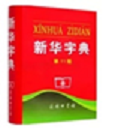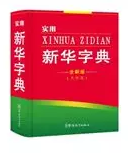On 28 December 2017 the Beijing IP Court rendered a groundbreaking decision by awarding the owner of an unregistered well-known trademark Rmb3 million in damages for infringement.
According to Article 13.2 of the Trademark Law (2013 version), the owner of an unregistered trademark can prevent a third party from registering or using an identical or similar trademark on the same or similar goods. However, the law is silent as to whether the owner of such a mark can seek damages from third-party users and, prior to the Beijing IP Court's decision, no damages award had ever been granted to the owner of an unregistered well-known trademark.
The dispute concerned The Commercial Press (TCP) – which has published the well-known Xinhua Dictionary (Figure 1) since 1957 – and Sinolingua Corporation, a Chinese company which published dictionaries which bore 新华词典 (Xinhua Dictionary in Chinese characters) and imitated the trade dress of TCP's Xinhua Dictionary (Figure 2).

Figure 1 – 11th edition of TCP's Xinhua Dictionary

Figure 2 – Sinolingua's Xinhua Dictionary
Unfortunately, TCP had never registered XINHUA DICTIONARY in Chinese characters as a trademark.
TCP initiated an action against Sinolingua before the Beijing IP Court, seeking recognition of the well-known status of the 新华词典 trademark (Xinhua Dictionary in Chinese characters) and an injunction requiring Sinolingua to cease its use thereof. TCP further claimed that the imitation of its trade dress constituted an act of unfair competition and requested Rmb3 million in damages.
The court recognised that 新华词典 constitutes an unregistered well-known trademark. It specified that the title of a book may detach itself from the content thereof and function as a source identifier, thus becoming worthy of protection.
On the matter of unfair competition, the court was satisfied with the two prerequisite conditions for finding that an act of unfair competition had been committed – namely, that:
- TCP's Xinhua Dictionary was a famous product; and
- the decoration (ie, trade dress) of the book was peculiar and functioned as a source identifier.
The court granted the injunction to stop using the trademark on the basis of both the Trademark Law (unregistered well-known trademark) and the Anti-Unfair Competition Law.
The court then faced the difficult task of determining the legal basis for awarding damages. Article 13 of the Trademark Law only prohibits a third party from registering or using an identical or similar trademark on the same or similar goods and makes no reference to infringement and compensation. Further, in 2002 the Supreme People's Court published the Interpretation of the Supreme People's Court on Several Matters Regarding the Application of Law in Trial of Trademark Civil Dispute Cases, in which it distinguished between Articles 13.2 (now 13.3) and 13.1 (now 13.2) of the Trademark Law. According to the Supreme People's Court, the use of a registered well-known trademark on different goods (Article 13.2) is to be considered an act of infringement allowing for a damages award, whereas the use of an unregistered well-known trademark (Article 13.1) is protected only against confusion by way of an injunction prohibiting the use of such mark.
In other words, the Supreme People's Court introduced the possibility of awarding damages in the context of Article 13.2, but simply reiterated Article 13.1 as it stood. As such, the people's courts interpreted the Supreme People's Court's approach to mean that no damages could be awarded to owners of unregistered well-known trademarks.
However, in the case at hand, the Beijing IP Court refused to be restrained from indemnifying the plaintiff.
The court first cited the Tort Liability Law, which provides that where civil rights (which include trademark rights) are violated, the violator should pay compensation for the damage caused.
The court then cited the Anti-Unfair Competition Law and Article 17 of the Interpretation of the Supreme People's Court on Some Matters Concerning the Application of Law in the Trial of Civil Cases Involving Unfair Competition (1 February 2007), which provides that the "amount of compensation… [may be] determined by reference to… the infringement of the exclusive right to use a registered trademark".
The court therefore applied the prejudice calculation method provided for in cases of infringement of a registered trademark in the Trademark Law. Further, the court cited Article 63.1 of the Trademark Law (2013 version), which provides that, in case of bad faith where the infringement is serious, the amount of compensation may be increased up to three times (punitive damages).
The court ascertained that the profit earned by the defendant was Rmb2,293,017.064. It decided to impose punitive damages by multiplying this amount by one-and-a-half, the sum of which exceeded the Rmb3 million claimed by TCP. As the court could not award the plaintiff more than the amount sought, it granted TCP the full amount claimed.
This case has been selected as one of the Supreme People's Court's and the Beijing IP Court's top 10 IP rights cases for 2017.
This case illustrates how the IP courts are taking a more flexible approach to interpreting the law in order to address the issues brought before them.
Notably, the day before the Beijing IP Court rendered its judgment, the Shanghai IP Court issued a judgment in a different case which presents certain similarities and confirms this new trend. The Shanghai case concerned French winemaker Lafite Rothschild and two Shanghai companies, Mellowines Development Co, Ltd and SAFE International Logistics Co, Ltd. Lafite had filed the Chinese version of its trademark with the China Trademark Office and obtained the preliminary approval. However, an opposition action was filed, meaning that the LAFITE mark did not obtain final approval until after the opposition procedure, which was much later.
According to the law, the LAFITE mark was valid on the expiration of the three-month period following the publication of the preliminary approval. However, there was a long gap between the validity date and the date of the decision putting an end to the opposition procedure. Mellowines and SAFE had used the mark during that period, so Lafite sued for infringement and damages. The court ruled that, during such period, Lafite's trademark was to be considered an unregistered well-known trademark and that, as such, it should be entitled to damages. The court also noted that the defendant had acted in bad faith.
The new Anti-Unfair Competition Law – which was revised on 4 November 2017 and entered into force on 1 January 2018 – now follows the Trademark Law and provides for statutory damages of Rmb3 million. Unfortunately, it does not mention punitive damages. It will be interesting to see whether the people's courts grant such punitive damages by referring to the still valid Supreme People's Court 2007 judicial interpretation.
For further information on this topic please contact Hui Huang or Paul Ranjard at Wanhuida Peksung by telephone (+86 10 6892 1000) or email ([email protected] or [email protected]). The Wanhuida Peksung website can be accessed at www.wanhuida.com and www.peksung.com.
This article was first published by the International Law Office, a premium online legal update service for major companies and law firms worldwide. Register for a free subscription.




